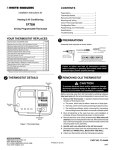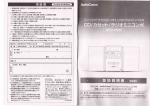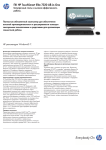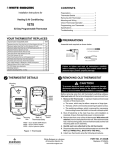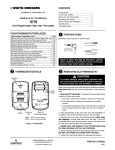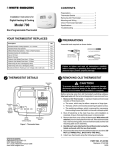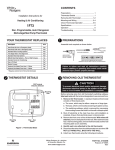Download Emerson 1F78H Air Conditioner User Manual
Transcript
CONTENTS Installation Instructions for Preparations .................................................. 1 Thermostat Details ........................................ 1 Removing Old Thermostat ............................ 1 Mounting and Wiring ..................................... 2 Check Thermostat Operation ........................ 3 Configuration Menu ....................................... 4 Specifications ................................................ 5 Troubleshooting ............................................ 5 Heating & Air Conditioning 1F78H Non-Programmable Thermostat YOUR THERMOSTAT REPLACES Typical System Compatibility Chart 1 1F78H Standard Heat Only Gas or Oil Fired Systems (24 volt)* Electronic Ignition Heat Only Two Wire Systems (24 volt)* Yes Yes Electronic Ignition Heat Only Gas or Oil Fired Systems (24 volt)* Standard Heat/Cool Systems (24 volt)* Yes Yes Heat/Cool Systems Electric Heat (24 volt)* Heat Only Electric Heat Systems (24 volt)* Cool Only Systems (24 volt)* Heat Pump Systems (No Aux or Emergency Heat)* Hot Water Zone Heat Only Systems Hot Water Zone Heat Only (Three Wire) Systems Line Voltage Heating or Baseboard 110/240 Volt Systems Millivolt Systems Floor or Wall Furnaces 12 VDC Mobile Home Application Multistage Systems Systems Exceeding 30VAC, 1.5 Amp Yes Yes Yes Yes No No No No No No No PREPARATIONS Assemble tools required as shown below. FLAT BLADE SCREWDRIVER WIRE CUTTER/STRIPPER HAND OR POWER DRILL WITH 3/16 INCH DRILL BIT, IF NEEDED SPIRIT LEVEL OR PLUMB BOB AND LINE OPTIONAL— THERMOSTAT DOES NOT NEED TO BE LEVEL TO WORK PROPERLY Failure to follow and read all instructions carefully before installing or operating this control could cause personal injury and/or property damage * Requires common wire for 24VAC at the thermostat 2 THERMOSTAT DETAILS 3 REMOVING OLD THERMOSTAT ! CAUTION Mounting hole To prevent electrical shock and/or equipment damage, disconnect electrical power to the system at the main fuse or circuit breaker until installation is complete. W Mounting hole W905 Clip for Hydronic System RH C G W904 W905 ELEC GAS W904 Clip for Celsius Display Electric/Gas Switch Figure 1. Thermostat base WHITE-RODGERS EMERSON ELECTRIC CO. 9797 REAVIS ROAD ST. LOUIS, MISSOURI 63123-5398 www.white-rodgers.com B O RC Y Before removing wires from old thermostat’s switching subbase, label each wire with the terminal designation it was removed from. 1. Remove Old Thermostat: A standard heat/cool thermostat consists of three basic parts: a. The cover, which may be either a snap-on or hinge type. b. The base, which is removed by loosening all captive screws. c. The switching subbase, which is removed by unscrewing the mounting screws that hold it on the wall or adaptor plate. 2. Shut off electricity at the main fuse box until installation is complete. Ensure that electrical power is disconnected. 3. Remove the front cover of the old thermostat. With wires still attached, remove wall plate from the wall. If the old thermostat has a wall mounting plate, remove the thermostat and the wall mounting plate as an assembly. 4. Identify each wire attached to the old thermostat. 5. Disconnect the wires from the old thermostat one at a time. DO NOT LET WIRES FALL BACK INTO THE WALL. 6. Install new thermostat using the following procedures. PART NO. 37-6450A Printed in U.S.A. 0247 3 REMOVING OLD THERMOSTAT ! CAUTION CONTINUED FROM FIRST PAGE ATTENTION! This product does not contain mercury. However, this product may replace a unit which contains mercury. Do not open mercury cells. If a cell becomes damaged, do not touch any spilled mercury. Wearing non-absorbent gloves, take up the spilled mercury and place into a container which can be sealed. If a cell becomes damaged, the unit should be discarded. Mercury must not be discarded in household trash. When the unit this product is replacing is to be discarded, place in a suitable container and return to White-Rodgers at 2892 Harrison Street, Batesville, AR 72501-2117 for proper disposal. 4 MOUNTING AND WIRING ! Take care when securing and routing wires so they do not short to adjacent terminals or rear of thermostat. Personal injury and/or property damage may occur. TERMINAL CROSS REFERENCE CHART New Thermostat Terminal Designation RH Other Manufacturers’ Terminal Designation * 4 RH M R RC R R V - G G G F G W W W H W Y Y Y C Y C C C X C * Factory installed jumper wire between the RH and RC terminals must remain in place. WARNING Do not use on circuits exceeding specified voltage. Higher voltage will damage control and could cause shock or fire hazard. Do not short out terminals on gas valve or primary control to test. Short or incorrect wiring will damage thermostat and could cause personal injury and/or property damage. Thermostat installation and all components of the system shall conform to Class II circuits per the NEC code. Electric Heat or Single-Stage Heat Pump Systems This thermostat is configured from the factory to operate a heat/ cool, fossil fuel (gas, oil, etc.), forced air system. It is configured correctly for any system that DOES NOT require the thermostat to energize the fan on a call for heat. If your system is an electric or heat-pump system that REQUIRES the thermostat to turn on the fan on a call for heat, locate the GAS/ELECTRIC switch (see fig. 1) and switch it to the ELECTRIC position. This will allow the thermostat to energize the fan immediately on a call for heat. If you are unsure if the heating/cooling system requires the thermostat to control the fan, contact a qualified heating and air conditioning service person. Attach Thermostat Base to Wall 1. Remove the packing material from the thermostat. Gently pull the cover straight off the base. Forcing or prying on the thermostat will cause damage to the unit. If necessary, move the electric heat switch (see ELECTRIC HEAT SYSTEMS, above). 2. Connect wires beneath terminal screws on base using appropriate wiring schematic (see figs. 2 through 7). 3. Place base over hole in wall and mark mounting hole locations on wall using base as a template. 4. Move base out of the way. Drill mounting holes. 5. Fasten base loosely to wall, as shown in fig. 1, using two mounting screws. Place a level against bottom of base, adjust until level, and then tighten screws. (Leveling is for appearance only and will not affect thermostat operation.) If you are using existing mounting holes, or if holes drilled are too large and do not allow you to tighten base snugly, use plastic screw anchors to secure subbase. 6. Push excess wire into wall and plug hole with a fire-resistant material (such as fiberglass insulation) to prevent drafts from affecting thermostat operation. Hydronic (Hot Water or Steam) Heating Systems This thermostat is set to operate properly with a forced-air heating system. If you have a hydronic heating system (a system that heats with hot water or steam), you must set the thermostat to operate properly with your system by changing the first option in the configuration menu to SL (see configuration menu, page 5). www.white-rodgers.com 4 MOUNTING AND WIRING CONTINUED FROM SECOND PAGE JUMPER WIRE THERMOSTAT C B Y G W Cooling System Fan Relay Heating System O RC RH THERMOSTAT C B Y O G W RC SYSTEM RH SYSTEM NOTE Fan Relay For Heat only, attach to RH and W Heating System Hot 24 VAC 120 VAC Neutral Hot 24 VAC HEATING TRANSFORMER 120 VAC Neutral Hot TRANSFORMER 24 VAC 120 VAC Neutral Figure 2. Typical wiring diagram for heat only, 4-wire, single transformer systems COOLING TRANSFORMER Figure 5. Typical wiring diagram for heat/cool, 6-wire, two-transformer systems JUMPER WIRE THERMOSTAT C B O Y G W RC RH SYSTEM Cooling System JUMPER WIRE JUMPER WIRE THERMOSTAT Fan Relay C Hot 24 VAC B Y O G W RC RH SYSTEM 120 VAC Reversing Compressor Fan Valve* Contactor Relay Neutral TRANSFORMER Hot 24 VAC Figure 3. Typical wiring diagram for cool only, 4-wire, single transformer systems * Reversing valve is energized when the system switch is in the COOL position Figure 6. Typical wiring diagram for heat pump with reversing valve energized in COOL NOTE RED jumper wire (provided with thermostat) must be connected between thermostat RH and RC terminals for proper thermostat operation with this system. JUMPER WIRE JUMPER WIRE THERMOSTAT C B O Y G W RC Fan Relay Heating System C O Y G W RC RH SYSTEM Compressor Fan Contactor Relay * Reversing valve is energized when the system switch is in the HEAT position TRANSFORMER Hot 24 VAC 120 VAC Neutral 120 VAC Neutral TRANSFORMER Figure 7. Typical wiring diagram for heat pump with reversing valve energized in HEAT Figure 4. Typical wiring diagram for heat/cool, 5-wire, single transformer systems 5 B Reversing Valve* Hot 24 VAC JUMPER WIRE THERMOSTAT RH SYSTEM Cooling System 120 VAC Neutral TRANSFORMER CHECK THERMOSTAT OPERATION NOTE To prevent static discharge problems, touch side of thermostat to release static build-up before touching any keys. If at any time during testing your system does not operate properly, contact a qualified serviceperson. Fan Operation If your system does not have a G terminal connection, skip to Heating System. 1. Turn on power to the system. 2. Move fan switch to ON position. The blower should begin to operate. 3. Move fan switch to AUTO position. The blower should stop immediately. Cooling System ! CAUTION To prevent compressor and/or property damage, if the outdoor temperature is below 50°F, DO NOT operate the cooling system. This thermostat has a time delay between cooling cycles to allow the head pressure in the compressor to stabilize. If the temperature is adjusted to call for cool within 5 minutes of the last cycle the snowflake icon will blink indicating the thermostat is locked out. After 3 to 5 minutes, the compressor will start and the snowflake icon will stop flashing. This helps prevent the compressor from cycling too quickly and is normal operation for the thermostat. 1. Move SYSTEM switch to COOL position. 2. Press to adjust thermostat setting below room temperature. The blower should come on immediately on high speed, followed by cold air circulation 3. Press to adjust temperature setting above room temperature. The cooling system should stop operating. Heating System 1. Move SYSTEM switch to HEAT position. If the heating system has a standing pilot, be sure to light it. 2. Press to adjust thermostat setting above room temperature. The heating system should begin to operate. 3. Press to adjust temperature setting below room temperature. The heating system should stop operating. www.white-rodgers.com 5 CHECK THERMOSTAT OPERATION CONTINUED FROM THIRD PAGE 1 Before you begin using your thermostat, you should be familiar with its features and with the display and the location and operation of the thermostat buttons. Your thermostat consists of two parts: the thermostat cover and the base. To remove the cover, gently pull it straight out from the base. To replace the cover, line up the cover with the base and press gently until the cover snaps onto the base. 2 WHITE-RODGERS The Thermostat Buttons and Switches FAN SYSTEM ON AUTO COOL OFF HEAT 1 (Up arrow) Raises temperature setting. 2 (Down arrow) Lowers temperature setting. 3 3 FAN switch (ON, AUTO). 4 4 SYSTEM switch (COOL, OFF, HEAT). The Display 5 6 7 is displayed when the SYSTEM switch is in the HEAT position. is displayed (non-flashing) when the SYSTEM switch is in the COOL position. is displayed (flashing) when the compressor is in lockout mode. 5 6 Displays current temperature. Figure 8. Thermostat display, buttons, and switches 7 Displays currently set temperature (this is blank when SYSTEM switch is in the OFF position). 6 Operating Features Now that you are familiar with the thermostat buttons and display, read the following information to learn about the many features of the thermostat. • SIMULTANEOUS HEATING/COOLING SETPOINT STORAGE — You can enter both your heating and cooling setpoints at the same time. There is no need to re-enter the thermostat at the beginning of each season. • TEMPERATURE SETTING — Press or until the display shows the temperature you want. The thermostat will keep the room temperature at the selected temperature. • °F/°C CONVERTIBILITY — The factory default setting is Fahrenheit. If you need Celsius temperature setting, go to menu mode and change the fifth option to C (see configuration menu, page 5). • TEMPERATURE DISPLAY ADJUSTMENT — Your new thermostat has been accurately set in our factory. However,if you wish, you may adjust your new thermostat temperature display to match your old thermostat. This can be accomplished (within a ±4° range) by going into the menu mode (see configuration menu, page 5). CONFIGURATION MENU The configuration menu allows you to set certain thermostat operating characteristics to your system or personal requirements. With the system switch in “OFF” mode, press and keys at the same time to enter the configuration menu. The display will show the first item in the configuration menu. The configuration menu table summarizes the configuration options. An explanation of each option follows. Press and together momentarily to change to the next menu item. To exit the menu, change the system switch from OFF to HEAT or COOL. If no action is taken within fifteen minutes, the thermostat will revert to normal operation. 2) Select FA or SL (Fast or Slow) Heating Cycle Rate—The FA setting is frequently used for gas, oil or electric heat. The SL setting produces a longer heating cycle which is normally for hot water or steam (hydronic) systems. Both settings produce very accurate temperature control and can be set to your personal preference. FA cycles the system just under 1°F and the SL setting cycles at approximately 1.5F°. 3) Not Available 4) Select Compressor Lockout LOC OFF or ON—Selecting LOC ON will cause the thermostat to wait 5 minutes before turning on the compressor if the heating and cooling system loses power. It will also wait 5 minutes minimum between cooling cycles. This is intended to help protect the compressor from short cycling. Some newer compressors already www.white-rodgers.com Configuration Menu Step Press Button(s) 1 Set system switch to OFF 2 6) 8 Press or Comments to select: System switch must be OFF to configure thermostat and (FA) SL 3 and d-L (ON) OFF N/A 4 and LOC (OFF) ON Select compressor lockout OFF or ON 5 and 0 HI (0) 4 LO to 4 HI 6 and (F) C 7 Move system switch from OFF to HEAT or COOL * Press 5) Displayed (Factory Default) and Select FA or SL (Fast or Slow) heating cycle rate Select temperature display adjustment higher or lower Select temperature display to F or C Returns to normal operation simultaneously to advance to next item have a time delay built in and do not require this feature. Your compressor manufacturer can tell you if the feature is already present in their system. When the compressor time delay for about five minutes then turn on occurs it will flash the the compressor. Select Temperature Display Adjustment 4 LO to 4 HI— Allows you to adjust the room temperature display 4° higher or lower. Your thermostat was accurately calibrated at the factory but you have the option to change the display temperature to match your previous thermostat. Select F° or C° Readout—Changes the display readout to Centigrade or Fahrenheit as required. 7 SPECIFICATIONS ELECTRICAL DATA Electrical Rating: 20 to 30 VAC 50/60 Hz. 0.05 to 1.2 Amps (Load per terminal) 1.5 Amps Maximum Total Load (All terminals combined) THERMAL DATA Setpoint Temperature Range: 45°F to 90°F (7°C to 32°C) Operating Ambient Temperature Range: 32°F to 105°F Operating Humidity Range: 0 to 90% RH (non-condensing) Shipping Temperature Range: -40°F to 150°F TROUBLESHOOTING Symptom Possible Cause Corrective Action No Heat/No Cool/No Fan (common problems) 1. Blown fuse or tripped circuit breaker. 2. Furnace power switch to OFF. 3. Furnace blower compartment door or panel loose or not properly installed. Replace fuse or reset breaker. Turn switch to ON. Replace door panel in proper position to engage safety interlock or door switch. No Heat 1. Pilot light not lit. 2. System Switch not set to Heat. Re-light pilot. Set System Switch to Heat and raise temperature above room temperature. Verify thermostat and system wires are securely attached. Many furnaces have safety devices that shut down when a lock-out condition occurs. If the heat works intermittently contact the furnace manufacturer or local service person for assistance. Diagonistic: Set System Switch to Heat and raise the setpoint above room temperature. Within a few seconds the thermostat should make a soft click sound. This sound usually indicates the thermostat is operating properly. If the thermostat does not click on, contact your heating and cooling service person or place of purchase for a replacement. If the thermostat clicks, contact the furnace manufacturer or a service person to verify the heating is operating correctly. 3. Loose connection to thermostat or system. 4. Furnace Lock-Out Condition. Heat may also be intermittent. 5. Heating system requires service or thermostat requires replacement. www.white-rodgers.com 8 TROUBLESHOOTING Symptom Possible Cause Corrective Action No Cool 1. System Switch not set to Cool. Set System Switch to Cool and lower temp below room temp. Verify thermostat and system wires are securely attached. Same procedure as diagnostic for No Heat condition except set the thermostat to Cool and lower the setpoint below the room temperature. There may be up to a five minute delay before the thermostat clicks in Cooling. 2. Loose connection to thermostat or system. 3. Cooling system requires service or thermostat requires replacement. Heat, Cool or Fan Runs Constantly. 1. Possible short in wiring. 2. Possible short in thermostat. 3. Possible short in heat/cool/fan system. 4. Fan Switch set to Fan On. Check each wire connection to verify they are not shorted or touching together. No bare wire should stick out from under terminal screws. If the condition persists the manufacturer of your system or service person can instruct you on how to test the Heat/Cool system for correct operation. If the system operates correctly, replace the thermostat. Furnace Cycles Too Fast or Too Slow (narrow or wide temperature swing) 1. The location of the thermostat and/or the size of the Heating System may be influencing the cycle rate. Digital thermostats normally provide precise temperature control and may cycle faster than some older mechanical models. A faster cycle rate means the unit turns on and off more frequently but runs for a shorter time so there is no increase in energy use. If you would like to increase the cycle time, go to menu mode as mentioned in the instructions for Hydronic Heating Systems. It is not possible to shorten the cycle time. If an acceptable cycle rate is not achieved as received or by changing cycle time from FAST to SLOW on the menu mode contact a local service person for additional suggestions. Cooling Cycles Too Fast or Too Slow (narrow or wide temperature swing) 1. The location of the thermostat and the size of the Cooling System can influence the cycle rate. The cycle rate for cooling is fixed and can not be adjusted. Contact a local service person for suggestions. Thermostat Setting and Thermostat Thermometer Disagree 1. Thermostat thermometer setting requires adjustment. The thermometer can be adjusted +/- 4 degrees. See Temperature Display Adjustment in the Operation section. Blank Display and/or Keypad Not Responding 1. Thermostat loss of power 2. Voltage spike or static discharge. Check possible blown fuse or tripped breaker. Turn the system power off. Wait for 5 minutes and turn the power on. www.white-rodgers.com






